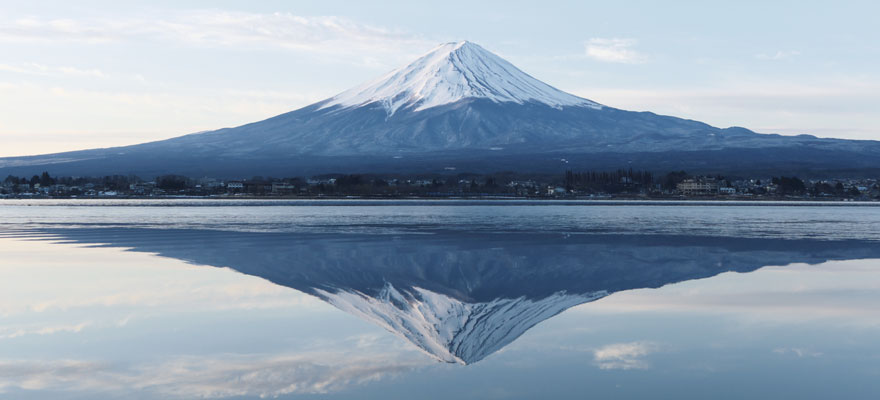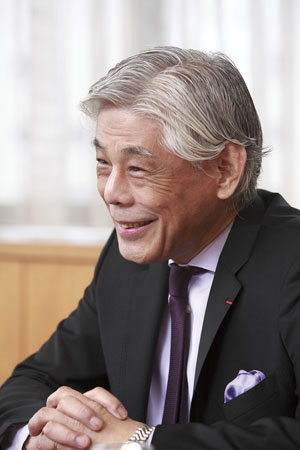Home > Highlighting JAPAN > Highlighting Japan September 2013 >Mount Fuji, World Heritage Site
Highlighting JAPAN
Mount Fuji: World Heritage Site
Mount Fuji
Now a UNESCO world heritage site

RISING 3776 meters above sea level, Mount Fuji towers majestically over the landscapes of Yamanashi and Shizuoka Prefectures and stands tall as an enduring symbol of Japan. On June 22 this year, it was decided that Mt. Fuji would become the 17th place in Japan to be added to the UNESCO World Heritage list. It became formal on the 26th of the same month. Twenty-five properties, a combination of natural and historic sites located in a 20,702.1 ha area, were given the inscription, "Fujisan, sacred place and source of artistic inspiration."
Gaining UNESCO World Heritage status for Mt. Fuji has been a long journey. One challenge in attaining this goal was to prove that the mountain and surrounding environment possess "outstanding universal values" that are important to the common legacy of humankind.
Mt. Fuji meets two of UNESCO's registration criteria for becoming a cultural heritage site: 1) To bear a unique or at least exceptional testimony to a cultural tradition or to a civilization which is living or which has disappeared; 2) To be directly or tangibly associated with events or living traditions, with ideas, or with beliefs, with artistic and literary works of outstanding universal significance.
Mt. Fuji met these criteria after a UNESCO committee considered the evidence that the mountain and environs represented outstanding universal values on the basis that it is both an object of worship and source of artistic inspiration. The 25 sites listed as World Heritage Site include the mountain itself, Lake Yamanaka and Lake Kawaguchi, the Oshino Hakkai springs (eight ponds fed by Mt. Fuji subsoil water), the Funatsu and Yoshida lava tree molds, the Shiraito no Taki waterfall and the Mihonomatsubara pine tree grove, as well the Oshi Jutaku Lodging Houses, Hitoana Fuji-ko Iseki and eight Shinto shrines.
Mt. Fuji's selection as a World Heritage Site will surely have a large impact on those outside of Japan. The mountain has long been conjured as a traditional and distinctly Japanese symbol for the country, but its new inclusion by UNESCO will undoubtly make it a more familiar landmark throughout the world. Travelers to Mt. Fuji vividly relate how moving the experience is, the beautiful, limpid vistas as you climb, the charming plant life everywhere, and the cold, soothing water that seeps out from the ground. This mountain is so beloved by Japanese that many people overseas long to see it at least once.
The inscription this year is only the beginning, however, of what will develop into a comprehensive system of planning and management for the Mt. Fuji UNESCO site. This will ensure the preservation of Mt. Fuji for the enjoyment and inspiration of citizens and visitors alike for future generations to come.
The subsequent articles will examine the outstanding universal values of Mt. Fuji as an object of worship and source of artistic inspiration, look at the current and future state of conservation, and offer some information with regard to visiting the region.
A Diplomatic Home Run
An Interview with Mr. Seiichi Kondo

For the first time in his 66 years, on August 1, 2012, Seiichi Kondo decided to climb to the top of Mount Fuji, a pilgrimage that almost every Japanese wishes to make at least once in their lifetime. Kondo took the Yoshida Trail and like many others, arrived at the top shortly before dawn. From the summit he was able to witness the sun rising in the East, a magical moment with the sky bursting forth with intense orange rays, unveiling valleys of mist below.
Pulling himself away, Kondo had another mission in mind. Hiking around the caldera at the summit, he looked down upon Suruga Bay through the morning clouds. Although not clearly visible, he could locate a small area at the further reaches of the coast that was to become his diplomatic signature – Mihonomatsubara. For Seiichi Kondo was not just another climber, but rather the Commissioner for Cultural Affairs who had been tasked to get the nation's most famous mountain area registered as a UNESCO World Heritage site.
Kondo's relationship with Mt. Fuji started when he was a child, spending all of his summer holidays on the beach in the town of Numazu, Shizuoka at the southern base of the volcano. From humble beginnings, he excelled in his schooling and eventually chose to become a diplomat. He was eventually appointed ambassador to UNESCO before finally becoming the head of the Cultural Affairs Agency of Japan in 2010.
The challenges in listing Mt. Fuji with UNESCO were considerable. The committee responsible for the decision must rule in favor that the area is a culturally important asset, since it must represent "outstanding universal values". The conditions for the International Council on Monuments and Sites (ICOMOS), an advisory body to UNESCO, is very strict.
As Kondo explains, "The ICOMOS panels look for clear, scientific evidence to prove that a proposed site has cultural value and to our surprise, it was recommended in May that while Mt. Fuji deserves inscription as World Heritage, Mihonomatsubara, a pine tree grove which is 45km away from the mountain, should be excluded. We had to explain that Mihonomatsubara is an integral part of Mt. Fuji. The mountain has been the source of inspiration for many famous art works and literature throughout the ages, such as Hokusai's ukiyo-e images, and Mihonomatsubara has frequently been depicted as a part of the mountain."
Luckily, the Japanese government had chosen its World Heritage representative well. In fact, former Prime Minister Yasuhiro Nakasone, president of the "National Congress for the Inscription of Mt. Fuji as World Heritage" is said to have told his close aids that he would not "leave this world" until he saw Mt. Fuji inscribed. Raising his spirits, Kondo brought his prior UNESCO relationship and strength of character to bear in convincing the various opinion leaders within the World Heritage Committee that Mihonomatsubara must be included as a part of World Heritage.
Kondo's diplomatic skill was put to the test in Phnom Penh in June 2013 when he had to court the World Heritage Committee. He started with the least agreeable representative, taking his time to explain that there is an intangible link between Mt. Fuji and Mihonomatsubara, therefore the latter must be inscribed. He eventually swayed this member not to dissent by using the non-confrontational style that is Kondo's trademark. The next candidate took half a day to persuade to vote in favor and the remaining committee members eventually fell in line with the consensus view. In the end, the support for the Mt.Fuji listing was unanimous – a home run for the Japan team.
The inscription of Mt. Fuji has strong personal meaning for Kondo. When he first became aware of the Advisory Body's recommendation to support the listing in early June 2013, he called on his father, Yoshikazu, in hospital to share the good news. Having happily received the news of his son's success, Yoshikazu passed away the following morning – a bitter-sweet moment for Seiichi Kondo
© 2009 Cabinet Office, Government of Japan






